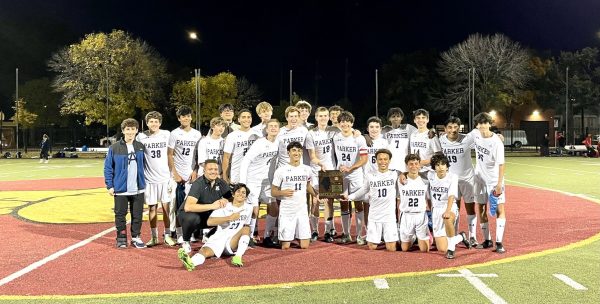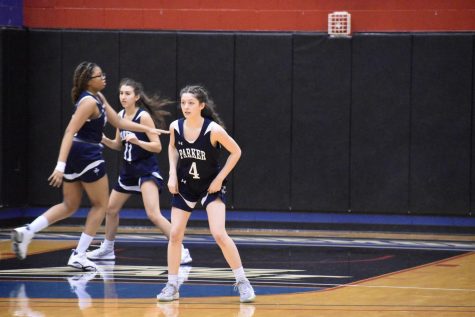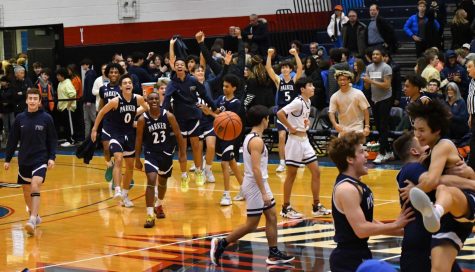Consistent Coaching
How Turnover Impacts Teams
Athletics have long been an integral part of the Parker tradition. Just a few steps inside the school’s entrance on Clark Street, Parker’s hallway is adorned with a glass case proudly displaying golden trophies and engraved plaques signifying various achievements like the Girls’ Soccer State Runner-Up trophy from 2013 and the Boys’ Soccer State Third Place Trophy from 2013.
Thanks to Parker’s no cut policy, allowing all students to participate in team sports as early as the sixth grade, a large number of students participate in athletics. In fact, according to Athletics director Bobby Starks approximately 77% of middle school students and 61% of high school students participate in at least one team sport. Given the high visibility of Parker’s sports programs and the large participation rate, expectations are high and recruiting and retaining great coaches become crucial.
One of Parker’s more successful programs in terms of participation and on-field success has been girls’ and boys’ soccer. Together, the soccer teams earned spots in the state tournament three out of the last six years between them.
The Varsity soccer teams are also two of the few teams in the school to have had the same coach. Neil Curran, during that time period. Senior soccer captain Rafi Derringer thinks that having a consistent coaching staff improves a team. “Because the coaches get to know the players as the years go on,” Derringer said, “they understand the best way to coach each individual as well as what their strengths and weaknesses are.”
Other sports have not been so lucky to have the same coach over that time period. Boys basketball, for example, has had three different head coaches in the last four years alone.h
The process for selecting and hiring coaches starts with the Human Resources (HR) department posting a listing for the job. On Parker’s website and on various job boards like the Illinois Basketball Association. Recently the listings have been sent to nearby colleges such as Depaul University and Loyola University.
Additionally, the athletics department considers hiring from within its internal network of staff, coaches, administrators, parents’ association, and teachers. For certain sports, quality candidates are easy to come by while other sports present more challenges. “Some sports are really tough to hire for,” Starks said. “For example field hockey is an east coast sport, and there is not a readily available a lot of coaches as there might be for basketball or baseball.”
Once the HR department has identified people interested in a job, they begin the formal interview process. Depending on the sport, sometimes a committee is formed comprised of administrators such as Ruth Jurgensen, Assistant Principal and Interim Upper School Head, or John Novick, Intermediate and Middle School Division Head.
In the interview process, the HR department or committee is looking not only at the candidate’s where they will have background and experience but also fit.. Starks said, “The interview process is definitely an art, not a science.” After interviews, a coach is chosen.
A goal is to find coaches that will stay with the program. During the interview Starks mentions that the school prefers a coach that will be willing to stay for many years. Consistency, Starks believes, is critical for team success.
“There’s a lot that a constant coach can provide that a one season coach cannot,” Starks said. “It is hard to switch strategy and tactics from year to year.”
Curran agrees. “The soccer and field hockey programs have benefitted from this,” he said. “We know the players and have watched them grow–-we see what has helped to make them better.”
Players benefit from coach consistency in other ways too. Former Parker soccer player Olivia Amdur (‘15) believes that working with the same coaches help the players communicate better. According to Amdur, this is important because it “helps everyone focus on and enjoy the game.”
Senior Casey Barr also thinks that consistency makes a difference. In baseball over the years, Barr believes that the team was disadvantaged by having different coaches. “We are not able to have one set of consistent systems,” Barr said. “We were constantly changing new systems every year, which hurt the success of the team.”
But the school understands when a coach gets a new job or moves out of state. This is not unusual given that the job is often part time, and coaches often leave to accept full time employment elsewhere. But coaches leave for other reasons too. According to Starks there have been very few times that coaches have left because they didn’t like the school, the students, or the administration.
It is hard to find somebody who is able to work within the hours facilities are available in the morning and afternoon after school. “We have been so fortunate to have several coaches who have been at Parker for a long time,” Starks said, “and who love what they are doing here and for all the right reasons.”







